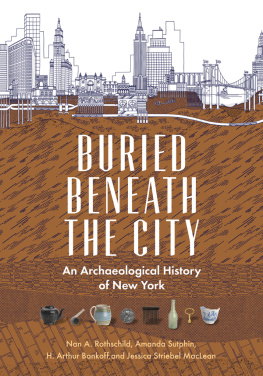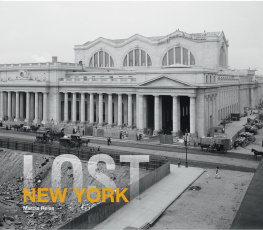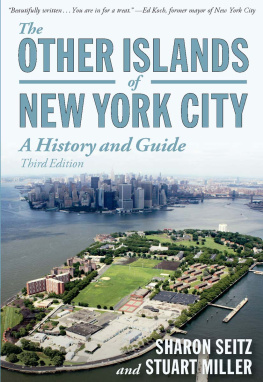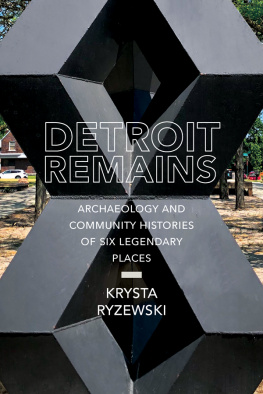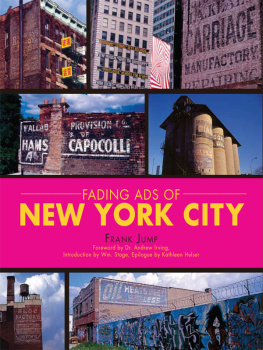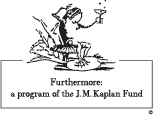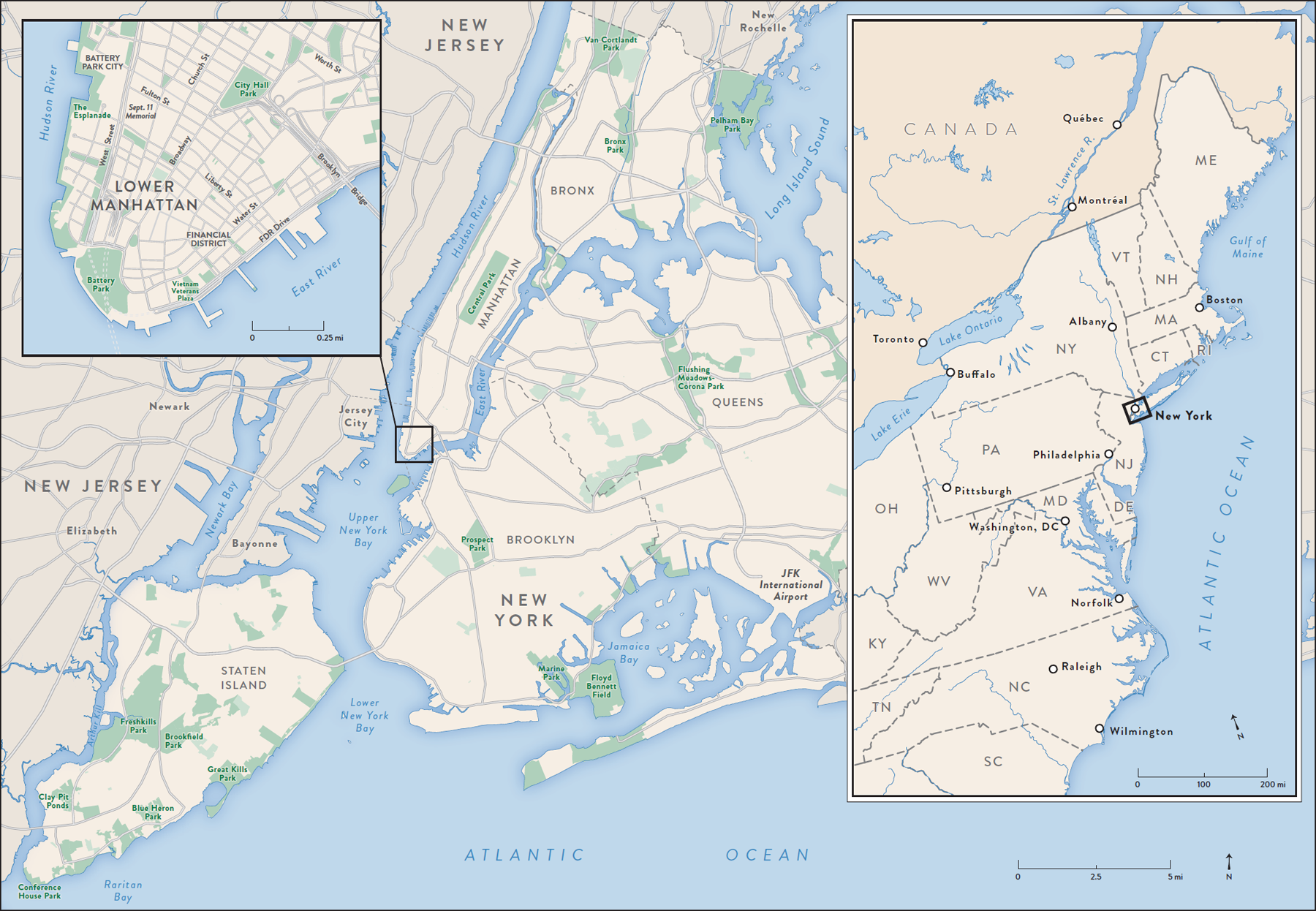Table of Contents
Buried Beneath the City
Buried
Beneath
the City
An Archaeological History
of New York
Nan A. Rothschild, Amanda Sutphin,
H. Arthur Bankoff, and Jessica Striebel Maclean
Columbia University Press
New York
Columbia University Press wishes to express its appreciation for assistance given by
Furthermore: a program of the J. M. Kaplan Fund in the publication of this book.
Columbia University Press
Publishers Since 1893
New YorkChichester, West Sussex
cup.columbia.edu
Copyright 2022 Nan A. Rothschild and Landmarks Preservation Commission
of the City of New York
All rights reserved
EISBN 978-0-231-55109-0
Library of Congress Cataloging-in-Publication Data
Names: Rothschild, Nan A., 1937 author. | Sutphin, Amanda, author. |
Bankoff, H. Arthur, author. | MacLean, Jessica Striebel, author. |
New York (N.Y.). Landmarks Preservation Commission.
Title: Buried beneath the city : an archaeological history of New York / Nan A. Rothschild,
Amanda Sutphin, H. Arthur Bankoff, and Jessica Striebel MacLean.
Other titles: Archaeological history of New York
Description: New York : Columbia University Press, [2022] | Includes bibliographical
references and index.
Identifiers: LCCN 2021036732 (print) | LCCN 2021036733 (ebook) | ISBN 9780231194945
(hardback) | ISBN 9780231194952 (trade paperback) | ISBN 9780231551090 (ebook)
Subjects: LCSH: New York (N.Y.)Antiquities. | Excavations (Archaeology)New York
(State)New York. | New York (N.Y.)History.
Classification: LCC F128.39 .R68 2022 (print) | LCC F128.39 (ebook) | DDC 974.7/1dc23
LC record available at https://lccn.loc.gov/2021036732
LC ebook record available at https://lccn.loc.gov/2021036733
A Columbia University Press E-book.
CUP would be pleased to hear about your reading experience with this e-book at .
Book design: Chang Jae Lee
Cover illustration: James Gulliver Hancock
Cover artifacts from left to right:
1) Black Lead-Glazed Teapot, Stadt Huys Project, Qi#203971:
https://archaeology.cityofnewyork.us/linker/collection/7/203971
2) Smoking Pipe, South Ferry Project, Qi#115653:
https://archaeology.cityofnewyork.us/linker/collection/7/115653
3) Dipped Pearlware Pitcher, Van Cortlandt Project, Qi#199563:
https://archaeology.cityofnewyork.us/linker/collection/7/199563
4) Commemorative Medal from the 1758 Battle of Louisbourg, South Ferry Project,
Qi#104227: https://archaeology.cityofnewyork.us/linker/collection/7/104227
5) Gutta-Percha Comb, Seneca Village, Qi#210746:
https://archaeology.cityofnewyork.us/linker/collection/7/210746
6) Glass Bottle, Van Cortlandt Project, Qi#:199715:
https://archaeology.cityofnewyork.us/linker/collection/7/199715
7) Brass Barrel Tap Key, 7 Hanover Square, Qi#208291:
https://archaeology.cityofnewyork.us/linker/collection/7/208291
8) Printed Whiteware Teacup, Stadt Huys Project, Qi#201505:
https://archaeology.cityofnewyork.us/linker/collection/7/201505
Contents
Regional map of New York City
B uried Beneath the City emerged through a collaboration between the New York City Landmarks Preservation Commission's Archaeology Department, represented by Amanda Sutphin, director of the department, Dr. H. Arthur Bankoff, special advisor to the chair, Dr. Jessica Striebel MacLean, urban archaeologist, and Dr. Nan Rothschild, research professor at Barnard College and professor emerita at Columbia University. The book uses artifacts and information uncovered in archaeological investigations in the five boroughs of New York City to help understand and illuminate the history of the city and its people.
The Landmarks Preservation Commission (LPC) is the largest municipal preservation agency in the nation. It is responsible for protecting New York Citys architecturally, historically, and culturally significant buildings and sites by granting them status as landmarks or historic districts and regulating them after designation. The agency is comprised of a commission of eleven commissioners, ten volunteers and a paid chair, all of whom are appointed by the mayor with the advice and consent of the city council, and supported by a staff of approximately eighty preservationists, researchers, architects, historians, attorneys, archaeologists, and administrative employees.
The commission was established in 1965 through groundbreaking legislation signed by the late Mayor Robert F. Wagner, in response to the losses of historically significant buildings. Most notable among these was the old Pennsylvania Station, which was demolished in 1963. There are now more than 37,500 designated buildings and sites in New York City across all five boroughs; most of them are located in over 150 historic districts.
LPC prioritizes designations that tell the stories of all New Yorkers and that reflect the citys history and communities. Archaeology can help reveal what the lives of everyday people of the past were like, as will be demonstrated throughout this book. The work of the Archaeology Department will be discussed in have an Archaeology Department. After many years of effort to consolidate the citys archaeological collections in one central location, in 2014 the department established the NYC Archaeological Repository: The Nan A. Rothschild Research Center (Repository) to curate the citys archaeological collections and to make them accessible to archaeologists, researchers, teachers, students, and the public. It is still an important part of the departments work. Located in Midtown Manhattan, in space donated by The Durst Organization, the Repository houses hundreds of thousands of artifacts from sites throughout the city and is open by appointment to researchers and scholars. As part of this project, the LPC worked with the Museum of the City of New York from 2013 to 2016 to create a comprehensive database of these collections, so they are available digitally to everyone. The Repository also launched a public website in 2016. Besides catalog information about the artifacts, the website has online exhibits, quizzes, and other features; it also accepts queries from the public. The collections in the Repository reveal the results of excavations and site assessments over the past forty years. The archaeological reports can be found online at the Landmark Preservation Commissions website. Almost all of the artifacts discussed in the book are curated in the Repository.
Archaeologists often seem to write only for other archaeologists. This book, on the other hand, is for anyone interested in New York City and its past. While containing technical material, it never forgets that history, especially as revealed through archaeological excavation, has a lure of its own. People are connected to their place, their city, their neighborhood, and they want to connect even to those who lived there before them. It is intriguing to know that mundane objects that were new in the past can still tell us something about their former users or owners, no matter that they are now battered and broken fragments.

